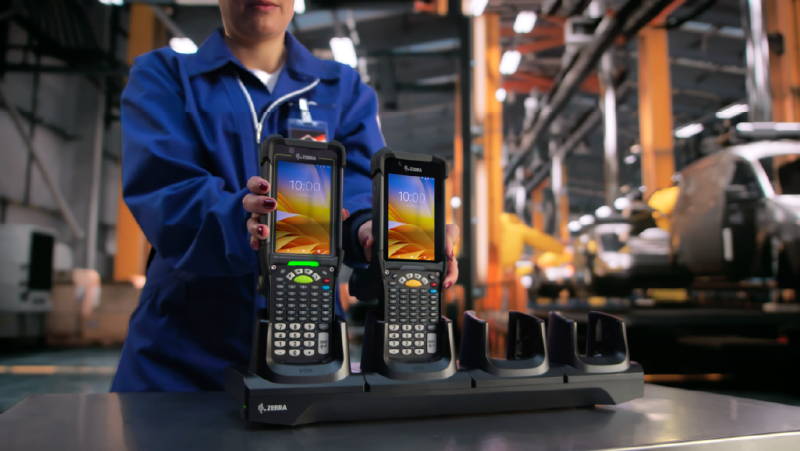Augmented Reality – from Ice Cream to the Production Line
- Trends
- Article
According to a study by the University of Washington, a full 65% of children have one or more imaginary friends. But that’s nothing compared to all the people out there chasing imaginary animals down real streets, or waiting with some help from their phone to give their ice cream just the right consistency. Augmented Reality (AR) is no longer just a figment of our imagination. And although it’s still currently most often used by game makers and advertisers, it’s now time to stop playing around and teach AR to work. Because we’re entering the age of imaginary co-workers who are constantly there to provide advice and aid while never complaining about anyone… including us.
The first words in the story of augmented reality were written in the late 1960s, but only today has reality enriched with computer-created elements become prominent. Just like with other technological inventions, the world had to wait for the arrival of affordable technologies that could support the original concept. Today, ordinary smartphones and tablets are ready to handle augmented reality.
The USA and China Lead the Way in the Implementation
According to research performed by Capgemini in 2018 among over 700 companies, more than half of the companies out there will be working to implement augmented reality during the next three years. In automotive, some say that it should become an absolute standard. The worldwide leaders in AR implementation are the USA, followed by China, France and Germany.

Capgemini research
Boeing has made use of augmented reality in aircraft cabling assembly and, by providing instructions and blueprints to its technicians in AR, it has shortened manufacturing time by 25%, increased productivity by 40% and cut down on errors. Similar benefits can be achieved in other fields of industry as well. In automotive and in manufacturing overall, AR can help to increase efficiency and productivity and save significant time. Where? For example during quality control and at assembly centres.
Assembly Using Augmented Reality
During assembly, augmented reality can make operators’ jobs easier and save time that would otherwise be wasted on reworking. AR makes it possible to show instructions step by step – and to inform operators of mistakes in real time as well. In the Czech Republic, this approach is being used by Škoda Auto, who use video mapping to aid the process of packing pallets destined for export. Throughout every step, the projection shows an image of the required part and its placement on the pallet, and it highlights any misplaced parts in red.
A multitude of similar cases can be found throughout the industry. We are ourselves engaged in augmented reality at present, and we see primarily the following benefits for its deployment at assembly centres:
- faster manufacturing times,
- fewer errors,
- better final product quality,
- step-by-step displaying of instructions,
- faster worker onboarding.
Quality Control in Augmented Reality
The best manufacturing products for putting AR to work here are those that are standardised in their shape, dimensions and other parameters, while also having a number of variants. In some products, the differences among individual configurations are furthermore indistinguishable to the human eye, and this is a space for the application of technologies that can uncover even tiny differences.

Quality control in augmented reality
We can cite as a practical example the pilot project that Aimtec has implemented for a major supplier of door panels for passenger automobiles. Our goal was to provide them with a tool that would make it possible to assess situations quickly, simply and in the same way every time. Augmented reality automatically informs them of any deviations from the required state and enables them to not only detect these deviations but also comprehensively register them for traceability. It thus replaces a long checklist that inspectors must otherwise run through for every part.
AR’s benefits for quality control:
- processes become digitalised and automated,
- traceability data is recorded automatically,
- errors are reduced.
So – Does it Pay to Invest in AR?
More and more often, it does. Even though the use of augmented reality is still in its beginnings, we see a large future for it. Today’s technologies already enable satisfactory results using even widely available hardware, with software playing the key role. A specialised team of developers is engaged in future development within our AimtecLab R&D platform. Our implementations make use of both the latest technologies from market leaders and time-tested, still-unchallenged standards. Aimtec’s main advantage here lies in its ability to successfully integrate all of these technologies into a single functional unit and thus harness an information system’s true potential. In our labs, we are testing and preparing for the industrial deployment of e.g. video mapping systems, special hand scanners and advanced software AR tools such as Vuforia.
Share article
Top stories from logistics, production and IT.
Subscribe to Aimtec Insights
By registering, you agree to the processing of your personal data by Aimtec as described in the Privacy policy.
Get top stories and articles
from Logistics, Production and IT.
Subscribe to Aimtec Insights
By registering, you agree to the processing of your personal data by Aimtec as described in the Privacy policy.







